![]()
![]()
![]()
Use LEFT and RIGHT arrow keys to navigate between flashcards;
Use UP and DOWN arrow keys to flip the card;
H to show hint;
A reads text to speech;
35 Cards in this Set
- Front
- Back
|
Complete flowers include |
Sepals (calyx) Petals (corolla) Stamen (androecium) male Pistil (female) |
|
|
Stamen (male) |
Filament (stalk) Anther |
|
|
H |
G |
|
|
Angiosperm differ from gymnosperms by having |
Ovule and seed enclosed within protective structure the pistil which later develops fruit |
|
|
Pollen is produced where |
Anther |
|
|
Pistil |
Female reproductive organs Ovary Stigma Style |
|
|
___ part of pistil that receives pollen |
Stigma |
|
|
Pistil can be simple or compound |
Single carpel Two or more carpels fused together |
|
|
Accessory floral parts |
Sepals & petals |
|
|
__ flowers have both male and female parts |
Perfect |
|
|
___ flowers are unisex |
Imperfect |
|
|
___ have floral parts arranged in 3 |
Monocots |
|
|
__ flowers arranged in 4 or 5 |
Dicots |
|
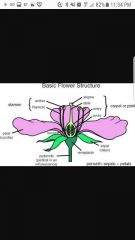
|
Flower parts labled |
|
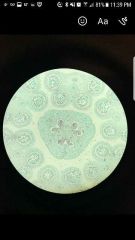
|
Tulip ovary |
|
|
Perigynous flower |
Sepals, petals, stamen arise from rim of hypanthium |
|
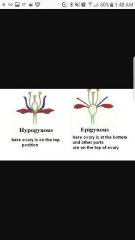
|
B |
|
|
Epigynous |
Having floral parts (such as the petals and stamens) attached to or near the upper part of the ovary, as in the flower of the apple, cucumber, or daffodil. |
|
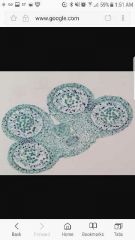
|
Lilium Anther first nuclear division |
|
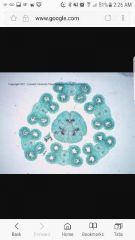
|
Lilium second nuclear division |
|
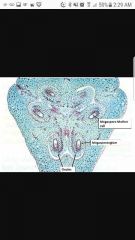
|
Lily ovulue |
|
|
Pollen development |
development in Flowering plantsPollen grains develop in the anthers of the staminae. In the anthers (figure A and detailed view D) mostly four, but sometimes only two loculi are present. In the loculi sporogenic tissue (from the Greek spora = seed and the Latin generare = produce) can be found from which pollen develop. At the inner side of each loculus a layer of large, rectangular cells, the tapetum (from the Greek tapes = carpet; t in figure D) can be found. The tapetum serves for the nutrition of the developing pollen, the deposition of cell wall material in the outer part of the pollen grain and other compounds in and over the wall. First, free pollenmothercells (PMC) are formed, which become spores by a meiotic division (see example of a meiotic stage in figure B). The meiosis involves two divisions, which lead to the formation of four daughter cells, the spores. Those four cells are originally still interconnected and are called tetrads (Greek Tetra = four; figure C). Later they come apart and the tapetum deposits the outer wall or exine (more on the pollen wall in pollen morphology). The exine protects the spore against dessication, mechanical pressure and ultraviolet radiation (figure F). Sometimes the exine layer is covered by sticky substances (pollenkitt, tryphine, elastoviscin and sporopollenin viscin threads), which are also produced by the tapetum. This adhesive material facilitates the attachment of pollen grains to insects, and in this way also zoophilic pollination. It also plays an important role in the adhesion of pollen grains to the female stigma and in the recognition between pollen and pistil. Also substances responsible for pollen allergy are often products originating from the tapetum. |
|

|
A. Cross-section through an anther of Lilie (Lilium)sp.) with on the left and the right side two loculi each. In the loculi sporemothercells (SMCs) can be seen from which the four spores develop through meiosis I and II. Inbetween the loculi of each pair a thin layer of cells (arrow) is visible along which the loculus can burst open atmaturity and release the pollen grains. In the middle the cross-sectioned filament (Fi) to which the anther is attached is indicated. In the upper part the vascular bundle (v) of the loculus can be distinguished.B. Loculus. The lumen contains developing pollen. On the inner wall (w) of the loculus a layer constitued of block-shaped single cells is present, the tapetum (t). The tapetum feeds the developing spore and -later- pollen.C. Tetrad stage during pollen development. After the two meiotic divisions the four daughter cells are still interconnected and form a tetrad. They are still surrounded by the wall (arrow) of the original cell, the microspore mothercell (MMC). D. Mitotic division in the spore leading to the formation of a microgametophyte or pollen. Only the metaphase is shown here. The chromosomes lay in the equatorial plane of the cell.E. Nearly ripe pollen grain: visible are a vegetative cell with nucleus (VN), which later will form the pollen tube, and a generative cell with its own nucleus (GN), which later will divide into two sperm cells.F. Ripe pollen grain in which the texture of the outer cell wall, the exine, can be recognized. The grainy dark purple structure in the middle of the pollen grain is the vegetative nucleus.G. Diagram in 3 parts: Ripe pollen grain consisting of the vegetative cell (VC) and therein the smaller generative cell (GC). After landing on the stigma (St) the pollen grain germinates and forms a pollen tube. In the pollen tube the generative cell divides into two sperm cells (SC). The pollen tube grows to the embryo sac (ES) and delivers the two sperm cells that are involved in double fertilization. |
|
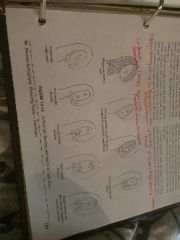
|
Ovule develooment |
|
|
Compare/contrast pollination & fertilization |
Firstly, pollination is the transfer of pollen from the anther (male organ of the flower) to the stigma (female organ of the flower) of the same or different flower. Secondly, fertilizationoccurs once the pollen grain reaches the stigma, it produces a pollen tube, which grows down through the style to the ovary. |
|
|
In __ the gametophyte generation takes place in a cone, which forms on the mature sporophyte plant. |
Gymnosperms |
|
|
Pollination must occur for ____ to take place. Zygotes develop into embryos inside seeds, from which the next sporophyte generation grows. |
Fertilization |
|
|
Importance of cones in gymnosperms life cycle |
Cones form on a mature sporophyte plant. Inside male cones, male spores develop into male gametophytes. Each male gametophyte consists of several cellsenclosed within a grain of pollen. Inside female cones, female spores develop into female gametophytes. Each female gametophyte produces an egg inside an ovule. |
|
|
Gymnosperms life cycle |
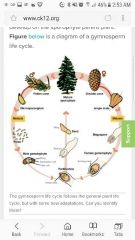
|
|
|
____ develop into pollen grains, which are the male gametophytes, while _____ form an ovule that contains the female gametophytes.In the ovule, the megasporocyte undergoesmeiosis, generating four megaspores; three small and one large; only the large megaspore survives and produces the female gametophyte (embryo sac). |
Microspores Megaspores |
|
|
In the ovule, the megasporocyte undergoes ___, generating four megaspores; three small and one large; only the large megaspore survives and produces the female gametophyte (embryo sac). |
Meiosis |
|
|
The two available sperm cells allow for to occur, which results in a diploidzygote (the future embryo) and a triploid cell (the future endosperm), which acts as a food store. |
Double fertilization |
|
|
the leaf of the embryo of a seed-bearing plant; after germination it becomes the first leaves of the seedling |
Cotyledon |
|
|
Either of two nucleated cells at the top of the embryo sac that aid in the production of the embryo; helper cells |
Synergrid |
|
|
Gymnosperm life cycle |
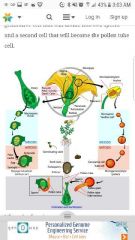
|

